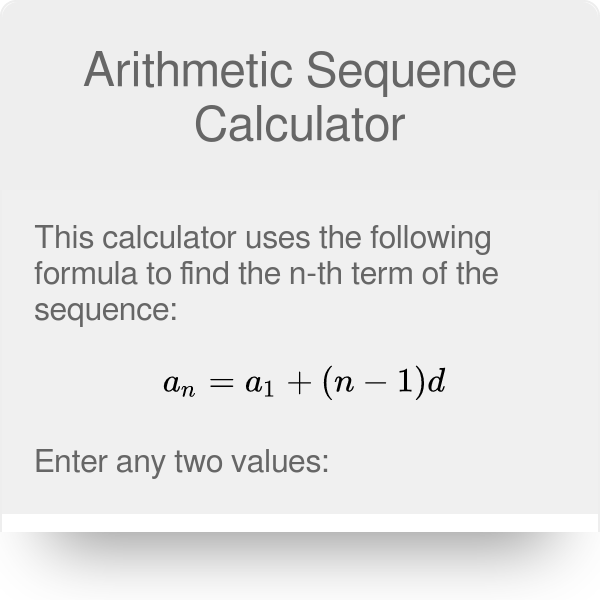
S n = a n + ( a n − d ) + ( a n − 2 d ) + … + a 1Īnd adding these two equations together, the terms involving d add to zero and we obtain n factors of a 1 + a n:Ģ S n = ( a 1 + a n ) + ( a 1 + a n ) + … + ( a n + a 1 ) 2 S n = n ( a 1 + a n )ĭividing both sides by 2 leads us the formula for the nth partial sum of an arithmetic sequence The sum of the first n terms of an arithmetic sequence given by the formula: S n = n ( a 1 + a n ) 2.

Therefore, we next develop a formula that can be used to calculate the sum of the first n terms, denoted S n, of any arithmetic sequence. However, consider adding the first 100 positive odd integers. S 5 = Σ n = 1 5 ( 2 n − 1 ) = + + + + = 1 + 3 + 5 + 7 + 9 = 25Īdding 5 positive odd integers, as we have done above, is managable. For example, the sum of the first 5 terms of the sequence defined by a n = 2 n − 1 follows: is the sum of the terms of an arithmetic sequence.
Sum of arithmetic sequence calculator series#
In some cases, the first term of an arithmetic sequence may not be given.Īn arithmetic series The sum of the terms of an arithmetic sequence. Next, use the first term a 1 = − 8 and the common difference d = 3 to find an equation for the nth term of the sequence.Ī n = − 8 + ( n − 1 ) ⋅ 3 = − 8 + 3 n − 3 = − 11 + 3 n Substitute a 1 = − 8 and a 7 = 10 into the above equation and then solve for the common difference d. In this case, we are given the first and seventh term:Ī n = a 1 + ( n − 1 ) d U s e n = 7. In other words, find all arithmetic means between the 1 st and 7 th terms.īegin by finding the common difference d. In fact, any general term that is linear in n defines an arithmetic sequence.įind all terms in between a 1 = − 8 and a 7 = 10 of an arithmetic sequence. In general, given the first term a 1 of an arithmetic sequence and its common difference d, we can write the following:Ī 2 = a 1 + d a 3 = a 2 + d = ( a 1 + d ) + d = a 1 + 2 d a 4 = a 3 + d = ( a 1 + 2 d ) + d = a 1 + 3 d a 5 = a 4 + d = ( a 1 + 3 d ) + d = a 1 + 4 d ⋮įrom this we see that any arithmetic sequence can be written in terms of its first element, common difference, and index as follows:Ī n = a 1 + ( n − 1 ) d A r i t h m e t i c S e q u e n c e

Here a 1 = 1 and the difference between any two successive terms is 2.

For example, the sequence of positive odd integers is an arithmetic sequence, An arithmetic sequence A sequence of numbers where each successive number is the sum of the previous number and some constant d., or arithmetic progression Used when referring to an arithmetic sequence., is a sequence of numbers where each successive number is the sum of the previous number and some constant d.Ī n = a n − 1 + d A r i t h m e t i c S e q u e n c eĪnd because a n − a n − 1 = d, the constant d is called the common difference The constant d that is obtained from subtracting any two successive terms of an arithmetic sequence a n − a n − 1 = d.


 0 kommentar(er)
0 kommentar(er)
